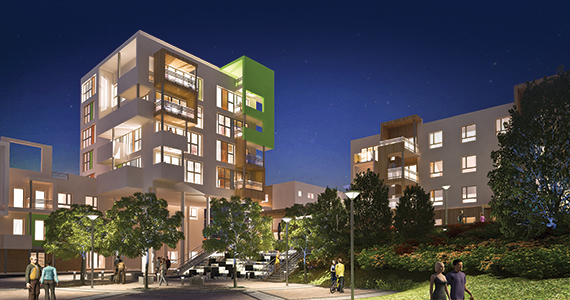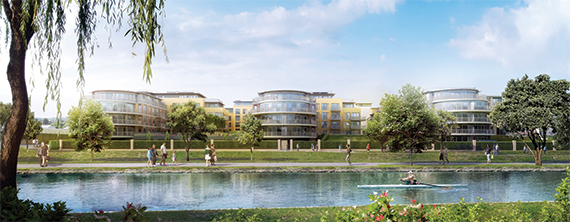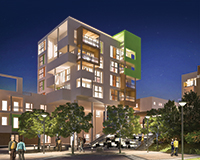 Cambridge has in recent years become an exemplar among UK cities for attracting employment, nurturing talent and encouraging development – but if you believe that combination has solved its considerable housing problem, think again.
Cambridge has in recent years become an exemplar among UK cities for attracting employment, nurturing talent and encouraging development – but if you believe that combination has solved its considerable housing problem, think again.
Research for Estates Gazette by Cambridge-based consultancy Bidwells reveals that while housing stock in the city has increased by 18% since 2001, and by 21% in neighbouring South Cambridgeshire, this has been more than matched by population growth. The forecast looks still more challenging: despite substantial housing stock growth anticipated by 2031, the city’s population again looks set to be bigger still.
This is despite a spike in housing completions since 2013, with delivery starting from large sites such as Countryside’s Great Kneighton near Cambridge city centre (2,500 homes when completed), and Barratt Homes’ Trumpington Meadows (eventually 3,700 units just south of the city boundary), as well as the completion of smaller schemes such as Crest Nicholson’s Kaleidoscope and Berkeley’s Cambridge Riverside.
“Recent build figures look good but the amount is nowhere near enough,” says Simon Elliott, an associate in Bidwells’ planning team. “So not only is there a shortage but there’s an affordability problem as demand far outstrips supply of the stock that does exist.”
Bidwells’ research – analysing data from local authorities, the government and the Land Registry – suggests that the population of Cambridge city, after a 10% rise in the past decade to 137,000, is set to rise to 151,000 by 2031.
Likewise, South Cambs’ population is now 153,000 after a 17% increase since 2001. It is expected to increase to more than 188,000 in the next 15 years.
Housing stock in both local authorities has grown dramatically in response to this surge in demand – but not enough to get ahead of the game.
Cambridge stock rose from 45,770 in 2006 to 51,120 by the end of 2015, while South Cambs increased from 57,230 in 2006 to 64,510 by late-2015. This still falls well short of the previous regional spatial strategy target within Cambridge city, and has failed to outstrip the growth in demand thanks to “natural” demographics, as well as inward migration prompted by economic growth.
That growth would be the envy of anywhere else in the UK, especially in an era of Brexit uncertainty: a Centre for Cities study has revealed that between 2010 and the end of last year, there had been a 31% rise in turnover of Cambridge-located businesses and a 26% hike in employment.
However, that has fuelled population growth. Since 2001, the number of households in Cambridge has grown by 20% to 53,300; in the next decade another 11% is forecast. Bidwells says expansion must then level off as sites will have been exhausted. South Cambs will see much more – a 24% increase in households by 2031.
This imbalance could be worsened by political shockwaves.
 “Many developments are investment-led – sometimes 60% to 80% of units are bought by investors – so Brexit and the additional homes stamp duty surcharge suppressed demand earlier this year, but that’s coming back now,” says Bidwells’ head of residential, David Bentley.
“Many developments are investment-led – sometimes 60% to 80% of units are bought by investors – so Brexit and the additional homes stamp duty surcharge suppressed demand earlier this year, but that’s coming back now,” says Bidwells’ head of residential, David Bentley.
While there is an opportunity for new sites to be identified through the current review process of both South Cambs’ and Cambridge city’s local plans, delays in the local authorities reaching this stage have meant recent successful applications on appeal have given the pipeline a more fragmented appearance.
“The strategy has been to put many eggs in a few baskets and rely on meeting demand through a few large sites – but it’s taking much longer than anticipated for these to deliver. As a consequence, developers are looking at smaller quick-fire sites to plug the gaps, at villages around Cambridge,” says Savills’ Cambridge planning director, David Henry.
The authorities’ philosophy of high-density building on a few sites is continuing, according to Gareth Wilson, planning partner at Barton Willmore, who says the current high reliance on a new settlement at Northstowe and a garden city-sized urban extension of Cambridge on the site of an existing airport has proven unable to deliver significant housing.
He fears more of the same and warns that what he calls a “top-heavy” approach means “a long-term and consistent inability to demonstrate a five-year housing land supply in South Cambridgeshire”. As a result, developers become more opportunistic, providing lower volumes of housing elsewhere if they can get consent, even on appeal.
Instead, Wilson calls for “development at every scale”, including intermediate and even small windfall schemes – as well as sensitive, planned release of green belt – instead of high volumes of new settlements vulnerable to delay.
He cites nearby East Hertfordshire council’s emerging district plan as a model: it takes a pragmatic approach to green belt release and targets 10% growth of housing in many villages.
A further argument against the strategy adopted by Cambridge and South Cambs authorities, perhaps, is the fact that some believe they have so far done little to foster the development of build to rent as a possible weapon in fighting the local housing shortage.
Unlike many cities, Cambridge has few secondary urban locations and accompanying low land costs to encourage development. With educational institutions still expanding and the city’s bio-medical campus forecast to create 20,000 professional jobs in the next 20 years – Brexit permitting – the absence of a new BTR sector may be a problem in a city where, according to Hometrack, the average price of a home to buy is now £407,200.
“Cambridge is a fantastic place to live, has a fabulous market to work in, and looks like it’s got a solid future for business and education,” says Bidwells’ Bentley. “But we have to face it – without a dramatic increase in supply, affordability will be its biggest problem.”












